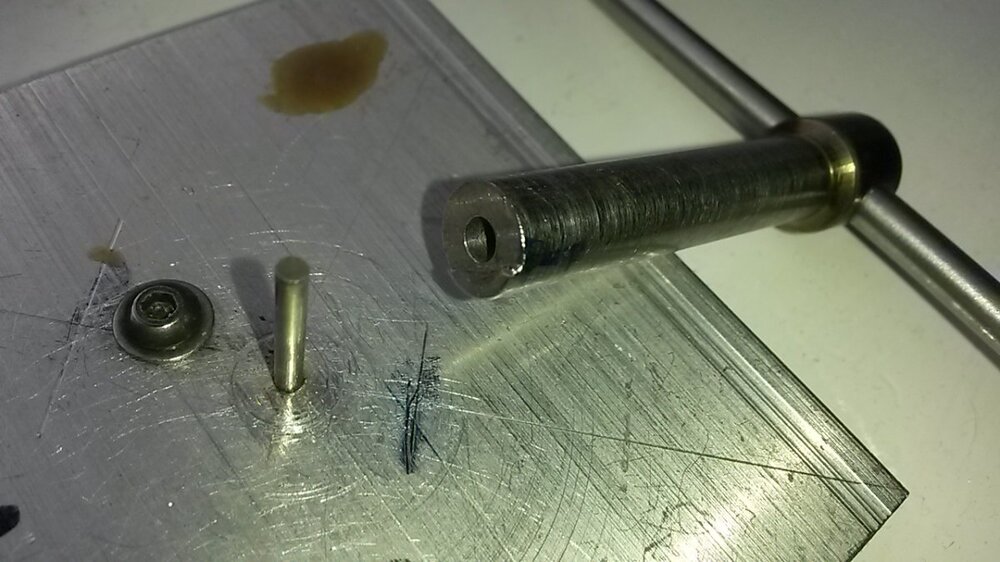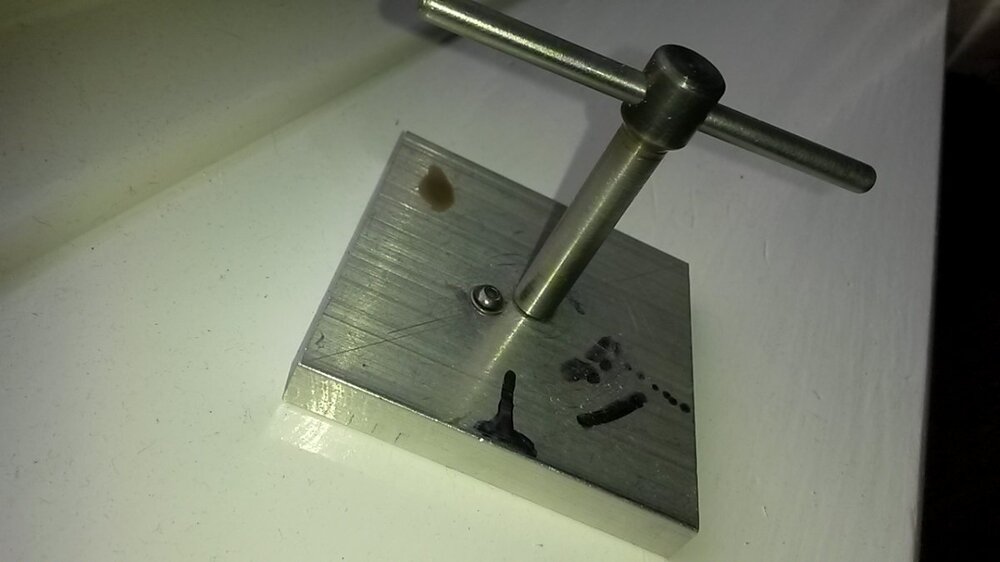
Tiposx
Members-
Posts
212 -
Joined
-
Last visited
Everything posted by Tiposx
-
Repair advice for inherited 1957 Lachenal
Tiposx replied to John Adamson's topic in Instrument Construction & Repair
If you are considering selling, you could try the “buy or sell” part of this forum. -
Dating A Lachenal From The Serial Number
Tiposx replied to johnconstable's topic in Concertina History
Many thanks, great work Wes -
Dating A Lachenal From The Serial Number
Tiposx replied to johnconstable's topic in Concertina History
Hi I am working on a Lachenal EC, a tutor model #47326. Could someone help with the date of manufacture please? Cheers -
Bravo! You must be really happy that you have managed to acquire such a fine instrument. I know that you have been looking for one for a long time, so well done!
-
If you can't get hold of used buttons then replacements can me made using a simple design. I have made them in one piece from T6 aluminium alloy. When polished they look pretty similar to the nickel capped originals, viewed from the outside. They can also be made from solud nickel silver, but this is quite a bit heavier than the original of course.
-
I probably over- complicated the description a little. Wood with a reasonably fine grain would be fine. An easier way to drill concentric holes would be to drill the major diameter first with a brad point bit to the correct depth. Then follow through with a twist bit. It doesn't take long to make. The main advantages of making such a jig are consistency and speed.
-
I use a jig, making the beads in batches. Drill the minor diameter all the way through a delrin plate. Then flip it and drill the major diameter part way, and slightly less depth than the thickness of the leather. Punch out the beads and pop them into the holes in the jig. Cover them with masking tape to prevent spinning. Flip the plate over onto a waste piece of wood and drill the minor diameter right through the bead. It doesn't take very long to do.
-
Any Chidley Duet concertina players out there?
Tiposx replied to Peter Smith's topic in General Concertina Discussion
The weight saving would be significant. -
5 inch, 32 button C/G anglo: "Tassey Tiger."
Tiposx replied to David Hornett's topic in Instrument Construction & Repair
They make the standard size look like baritones. I would love one of the 5” Tiger, alas only in my dreams. Any chance of a sound file or video please? -
My Duckling is very good. I didn't take very long to bush the buttons - the end frames are made from wood. I also made a set of conventional 7-fold bellows for mine.
-
Main "C" button on anglo valve pad keeps overlapping
Tiposx replied to Geoff W.'s topic in Instrument Construction & Repair
Looks like the rivet may have loosened its grip and is allowing the lever arm to wave around. That might just be the camera angle though. The pad has shifted out of it’s position. it should be easy enough to tilt and ease it back into place, I would try to gently twist it back by manipulating the black leather piece that connects the pad to the lever. If the pad falls off during the process then you just need a tiny blob of white glue to fix it. -
Dating A Lachenal From The Serial Number
Tiposx replied to johnconstable's topic in Concertina History
Thank you Stephen. -
Dating A Lachenal From The Serial Number
Tiposx replied to johnconstable's topic in Concertina History
Hi I would like to date a Boyd Lachenal 48 button I am restoring. The serial number is 44382 Any other info would be helpful. Thank you Tiposx -
Replacing springs.. what is the secret?
Tiposx replied to seanc's topic in Instrument Construction & Repair
Mine was inspired by Alex, but looks different. I clamp the foot of the spring against the allen bolt, clamp the long/loose end of the wire to my workbench and then wind the wire around the post. The T bar fits over the post and has a notch to help the wire around, and keep the coils tight and neat. You can do this job without the T bar. The main thing is to keep the tension up as you wind. The bends are put in with long nose pliers against a hard surface to bend the wire. I use .6mm ss spring wire. I use Evek in Germany via their website. I have bought from them several times including recently and the goods arrive here in the uk within a couple of days. -
Replacing springs.. what is the secret?
Tiposx replied to seanc's topic in Instrument Construction & Repair
The brass ones can also corrode unseen at the right angle where they enter the action board. They can be difficult to remove without snapping at that point. The stubs can be a problem to remove. My view is that the pioneers used the best material available to them at the time. If stainless steel had existed back then they would probably have used it. -
Replacing springs.. what is the secret?
Tiposx replied to seanc's topic in Instrument Construction & Repair
I place the spring end into the retaining hole, then manipulate the rest of the spring under/ onto the lever with the notched tool. The spring “never” pings off if you maintain a little tension. It takes about a minute to file the notch with a triangular needle file, it is worth trying out. You can still use the screwdriver as such if needed! -
Replacing springs.. what is the secret?
Tiposx replied to seanc's topic in Instrument Construction & Repair
I cut a notch in a small screwdriver, works perfectly. I tend to replace all the springs with stainless steel, they are easily made and tuned to the desired tension, but some people don't approve. -
Morse Albion baritone vs Morse Geordie baritone
Tiposx replied to Jim2010's topic in General Concertina Discussion
All the music I play (itm) falls within the range of the Albion, and of course the Geordie an octave lower. I can’t say for sure if the bigger size of my Baritone helps the lower notes, but it seems logical. The bigger size is really not an issue to me, it feels just right and sounds right somehow. It will be very interesting to hear about your comparison and your conclusions Jim. -
I have machined buttons from both delrin/ acetal and t6 aluminium successfully. The delrin takes a bit of practice to avoid it bending away from the tool. I use a collet chuck, polished carbide inserts, and a single cut for the peg and the button itself (if a cut is needed). It takes a few test cuts to get the measurements just right. The aluminium is pretty easy to machine using the same tooling, but lighter cuts can be used as it doesn’t, bend away from the tool excessively. It polishes up very nicely with grey scotchbrite followed by brasso on a cloth. I made a jig to make the through holes. Alex Holden has some really good info on his blog on making buttons on a small lathe - I used his methods.
-
Morse Albion baritone vs Morse Geordie baritone
Tiposx replied to Jim2010's topic in General Concertina Discussion
My Geordie Baritone is a young one - I bought it new in Feb 2021. My only mild criticism is the slightly stiff bellows. I will eventually get around to making a more flexible set of 7 folds, which I understand was an option. It doesn’t “need” them, but it would be nice. I should mention though that one of my gifted concertina playing friends can make it work really well - chords, sustained bass notes etc and he thinks the standard bellows are fine. -
Morse Albion baritone vs Morse Geordie baritone
Tiposx replied to Jim2010's topic in General Concertina Discussion
I can’t compare the two, but I have a MG baritone. It is slower on the low notes than it is on the higher notes. I think that is just physics though. There is no difference in speed note-for-note between it and my MA treble except that the standard baritone bellows are a little bit stiff and that the treble has slightly weaker springs and is a good bit lighter. I can play either standing up though. On the baritone I can keep up with my friends playing itm in their different octave, but technique needs to be good. Tippy tappy rather than pushing/ holding the button to its maximum, that is good technique for itm anyway, and the tone seems better. Tiposx -
Flatten then drill the bottom of the button, then insert the wire (or something light e.g. plastic) would be a sympathetic repair. You might not need glue if the fit is good. Over here you could buy some old buttons, not sure about S.A. Finding the correct size is a pain though. Those pegs are very important for a smooth action.







